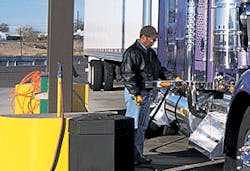Drivers and fuel are clearly among the top issues for trucking executives, given the most recent batch of quarterly earnings reports.
“We are facing the challenges of a tight driver market, high oil prices and a difficult regulatory environment,” said Robert Powell, chairman & CEO of Van Buren, AR-based truckload operator USA Truck.
“Those issues are becoming more acute for carriers as freight demand is starting to slow from last year’s record pace,” said Jerry Moyes, chairman & CEO of Phoenix-based Swift Transportation.
“Freight demand in the second quarter of this year was lower relative to a very strong second quarter of 2004,” he explained. “Volumes strengthened in June but are still below 2004 levels.”
“Demand has slowed from 2004,” said Kirk Thompson, president & CEO of Lowell, AR-based J.B. Hunt. “High and increasing oil prices and rising driver pay, along with other rising costs, will continue to exacerbate the financial difficulties faced by the marginally profitable [companies] in the truckload industry. We also see a shrinking supply of independent contractors, which we believe is a significant proxy for the plight of thousands of smaller and struggling motor carriers.”
The high cost of diesel fuel, in particular, is exacerbating the problems of trucking companies large and small, said Clarence Werner, chairman & CEO of Omaha, NE-based truckload carrier Werner Enterprises.
“Fuel prices rose for the eighth consecutive quarter, averaging 51 cents a gallon or 45% higher in second quarter of 2005 compared to second quarter of 2004,” he noted. “Sequentially, average prices rose 19 cents a gallon from the first to the second quarter this year, giving fuel expenses a two-cent negative impact on earnings per share in second quarter this year.
“The driver market remains extremely challenging,” Werner explained. “The supply of qualified truck drivers remains visibly constrained due to alternative jobs that are available with a solid economy and inadequate demographic growth for the industry’s targeted driver base over the next several years.”
“The driver shortage that has plagued the truckload industry for close to two decades is not going to be solved in a short time frame,” said Hunt’s Thompson.
“Due to demographic realities and structural barriers, such as low industry-wide pay scales, the qualified driver pool will continue to struggle as study after study has shown and, as those reports continue to project, shortages will continue well into the future,” he said. “Until qualified truck drivers become more plentiful – a scenario we certainly cannot envision any time soon – capacity will remain tight for the traditional truckload market and growth will remain subdued across the industry.”
About the Author
Sean Kilcarr
Editor in Chief
Sean Kilcarr is a former longtime FleetOwner senior editor who wrote for the publication from 2000 to 2018. He served as editor-in-chief from 2017 to 2018.
